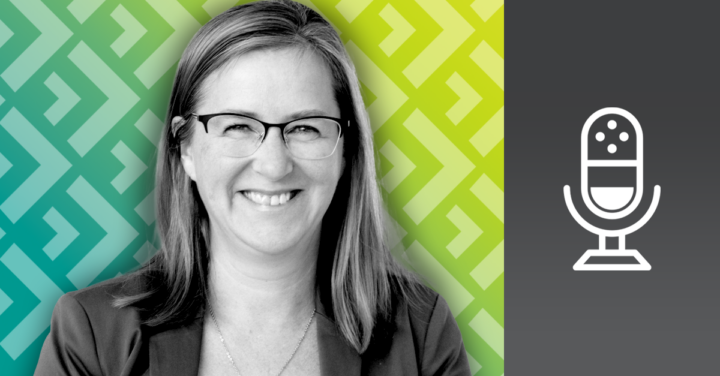
What is actuarial work in the field of workers’ compensation all about? In Part 2 of our chat alongside FCIA Julie Bélanger, actuary at the CNESST, we dive into the latest trends in occupational health and safety (on the pricing and claims side), the impact of the pandemic years, IFRS 17 and much more. Both Part 1 and 2 are available in French only.
CAN’T LISTEN TO THIS PODCAST? READ THE TRANSCRIPT.
Ayotte: Hello everyone and welcome to Seeing Beyond Risk, the podcast of the Canadian Institute of Actuaries. My name is Maude Ayotte, and I’m a member of the CIA communications team at Head Office.
In Part One of our two-part podcast episode, we spoke with Julie Bélanger, an FSA and FCIA who works as an actuary for the Commission des normes de l’équité, de la santé et de la sécurité du travail, or CNESST for short, about her experiences in the workers’ compensation sector.
In today’s Part Two, we welcome her back for an even deeper dive. Nice to see you again, Julie, and thanks for joining the podcast.
Bélanger: Hello Maude, I’m happy to be back.
Ayotte: So Julie, can you explain to us how insurance rating works in a workers’ compensation context?
Bélanger: Insurance rating is funded entirely by employers. So, employers are required to register with the Commission, and they pay all of the insurance premiums that cover the costs of the plan.
Our prime rating objective is to achieve equity among the employers. We try to distribute this big insurance bill as fairly as possible. We also try to foster workplace injury prevention and to encourage employers to return injured workers to employment as soon as possible in order to keep plan costs down.
In Quebec there are three risk-based rating methods. First, we have activities risk. What we do is categorize each employer according to the activities carried out in its business, and then establish contribution rates for each of these activities.
There are more than 170 different classification units for each possible activity. We establish a rate for each activity, and the employers are classified according to these activities. For slightly larger employers, consideration can be given to their individual experience with workplace injuries. So, we personalize the unit rate established just on the activity risk based on what we’ve observed in their file in previous years.
We have a four-year reference period. We look at an employer’s past four years to see if there have been accidents and this allows us to increase or decrease their classification unit rate.
So, we can give an employer a rebate if there were no accidents or a surcharge if there was an above average number of accidents or higher than average costs in relation to other employers carrying out the same activities. Basically, it’s our way of incentivizing employers to engage in prevention and lower costs by giving them credits if things are going well in their companies.
The size of the rebate or surcharge will depend on the size of the employer. So, if it’s not a very big employer, we definitely won’t view their experience as very meaningful, so the rebate or surcharge will be small. But if it’s a larger employer, we can take their experience more into account.
We’re also the only ones in Canada to have a retrospective plan that applies to very large employers. Experience is adjusted by looking at the past, how the accident year transpired, and then issuing a credit or debit for the year. We’ll look at how occupational injuries have evolved over the four years, and if things have gone poorly in relation to the anticipated risk for the year, the employer will be issued a surcharge, but retroactively.
Whereas for the personalized rate, we base this on the past to set the year’s contribution, but then we don’t touch this contribution depending on what happened during the year. So, with a personalized rate in 2023, if the employer pays a contribution of $25,000, we won’t touch this contribution to see whether or not this cost happened in the employer’s place of business.
It’s in the following year where we’ll look back at the accidents in 2023 to set the new rate, whereas for retrospective ratemaking, we really look at what happened during the year to set the employer’s contribution according to the true cost of the injuries.
Ayotte: In connection with that question, what occupational health and safety trend could make it necessary to create or develop more sophisticated risk models, when it comes to rating and claims?
Bélanger: In October 2021, the Act to modernize the occupational health and safety regime received assent. So, amendments were made to the plan to take new trends into account. Prevention mechanisms are to be expanded; psychosocial risks in the workplace will be more easily recognized; there will be a new approach to dispute resolution; and financial incentives may be developed for prevention. So, all of this has us working on models that aren’t necessarily for rating, but that will help the Commission deal with new ways of doing things and develop new practices. So, we’re helping our colleagues with that.
We’re also going to develop a bit of predictive modelling to validate our data and validate claims classification, to ensure they’re being assigned to the right classification units and stuff like that to help us keep track of what’s going on and to take advantage of the new methods being developed, particularly in predictive modelling.
Ayotte: If we look back on the past few pandemic years, what are the biggest impacts you’ve observed on risks?
Bélanger: The pandemic definitely altered the occupational health portrait over the past three years: 2020, 2021, 2022. There was a huge amount of COVID-related illness. When COVID was contracted at work, it was treated as a workplace accident. So, there was truly a lot of occupational illness associated with this disease, particularly in the health care sector, especially in 2020 in hospitals, extended care facilities and retirement homes.
It really changed our occupational health portrait because at the same time, in 2020, the economy was shut down, causing a large drop in workplace accidents in other sectors since there were a lot of people who had stopped working. And those who were teleworking had fewer accidents than what we had seen in the past, even in sectors that were already less risky. So, we really saw a changed occupational health landscape, and it continued right into 2022 because of the successive waves and the changes in the variants.
And it must also be said that rules were relaxed to accept COVID-19-related occupational illnesses. It was determined by default that if there was an outbreak in the workplace but the person who was submitting a claim, it was normally in connection with their work. These relaxed rules just ended on March 1, 2023. So, we’re back to the usual framework where it takes a medical certificate to indicate that it was an occupational accident that caused the claim.
The program Pour une maternité sans danger faced pressure because when the economy shut down, and with the COVID-19 risks, protective reassignments occurred much more easily than in the past. This pressure occurred mainly in 2020.
Things have been back to normal for a while now. What we’ll continue seeing in the future is telework, which means that certain types of accidents have decreased in offices, for example. There are things from the pandemic that we’ll continue to see.
Ayotte: Which recent reforms have had a significant impact in your work? In particular, how is IFRS 17 fitting in with your work?
Bélanger: I haven’t seen many differences in terms of IFRS 17 when it comes to rating, but since CNESST is considered to be an insurance company, it has to produce financial statements in conformity with IFRS 17. So, my actuarial valuation colleagues have to produce valuations that comply with this standard. But in terms of plan funding, it won’t change the way we do things, so we’ll continue to proceed on a best-estimate basis.
When we do valuation assumptions, we’re not looking to have margins for adverse deviations because we really want to have equity among generations of employers, so we don’t want to go looking more than necessary. We’re trying to fund as best we can based on what we think is going to happen in the future.
And if there are deviations, and obviously there are always deviations from what we had forecast, we have a funding policy allowing us to return any surpluses or look for deficits over a reasonable period. So as much as possible, we try to ensure that jobs that are open today pay for injuries that happen in 2023 as opposed to funding the past or the future. This will require us to continue carrying out valuations as we did in the past, while doing others for the financial statements that will conform to IFRS 17.
Ayotte: What is your vision for the future in your area of practice? For example, when it comes to reforms or issues connected with occupational health and safety risk valuations.
Bélanger: We’re definitely reviewing our rating methods to some extent, seeing how they compare to what takes place in other jurisdictions in Canada, the United States and even elsewhere in the world, to see if there are any emerging trends.
Our rating methods have been in place for 20 years, so we’re looking to see if there might be some updates that could be brought to the process. Although there haven’t been any problems per se that have been reported by the employers. It’s more a case of us trying to see whether we’re still up to date with our rating methods. We’ll also be tracking the effects of plan modernization.
The current modernization is going to bring new elements into consideration, such as psychosocial risks, financial incentives, things we’ll be able to look and see how they fit in with our models. We’ll continue to monitor the effects of the pandemic, if it carries on. Normally, with the March 1 return to the eligibility rules for occupational illnesses, we would expect a drop in the number of COVID illnesses. We’ll see if the other occupational illnesses, how things will go with current illnesses in health-related activity sectors.
We’re also in the process of reviewing the funding policy with our partners. This too is a policy that dates back a number of years, so we’ll be considering whether updates are needed and whether we should be taking IFRS 17 into account in our funding policy. These are things we need to look at, and another thing we’re looking closely at is the decisions by administrative tribunals in the area of imputation.
Since our rating is based on occupational injuries that occur at employers’ businesses, these injuries have to be assigned to an employer. There are provisions in the law whereby employers can apply for injuries to be partially removed from their file.
Quebec’s administrative tribunals are not bound by CNESST’s administrative policies, so we have to watch the tribunals for trends to see if there are things that need to be adjusted in line with their decisions so that our rating methods can be as accurate as possible, and so that what we call the costs that aren’t charged to an employer will be distributed as equitably as possible.
Ayotte: Do you have any final thoughts before we wrap up today’s conversation?
Bélanger: I work in a very exciting area of practice, with a front-row seat on the labour scene. I get to work with people from a variety of fields to promote occupational injury and illness prevention. So, I’m very happy to be working for CNESST.
Ayotte: Once again, thank you so much for taking the time to talk with us today, Julie.
Bélanger: It was my pleasure, Maude. Thanks.
Ayotte: Did you miss Part One of this conversation? Visit the Seeing Beyond Risk blog or listen wherever you get your podcasts. Did you enjoy today’s conversation? We invite you to subscribe to our podcast series and catch up on any episodes you may have missed in recent months.
My name is Maude Ayotte and I’d like to thank you for listening to Seeing Beyond Risk. Until next time!
This transcript has been edited for clarity.





